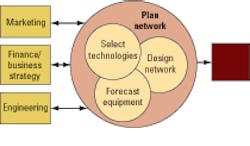VPIsystems has ‘OnePlan’ for network planning
Historically, carriers have relied on a patchwork of planning software that did not provide an integrated, “big picture” look at the network. Based on customer feedback, VPI has developed a modular system, dubbed “OnePlan,” that ties the company’s existing software modules into a single system that incorporates engineering, provisioning, purchasing, business planning, and marketing information. OnePlan serves as a single repository for network planning information, enabling carriers to build their networks based on actual need.
“What we’re bringing to the table is a planning capability that allows [carriers] to watch what’s going on in the marketplace, see what the take rates are, and replan on the basis of what is really happening,” explains Mark Mortensen, senior vice president of marketing for VPIsystems. With the emergence of bandwidth-hungry, image-based services like IPTV and HDTV, for example, simple network trending will not suffice, he says.
“One IPTV session is going to chew up something like 25 Mbits/sec of bandwidth, so carriers are starting to ask, ‘Hey, if we had a 5% penetration, what would that do to our transport network?’ But the problem is, you’re not sure if you’ll have 5% penetration, 10% penetration, or 1% penetration,” muses Mortensen. “Do you overbuild, figuring that it’s going to be 10%? That would make the marketing guy happy because his customers will get the right quality of service, but it would make the CFO unhappy,” he admits. “Or are you going to capital constrain [the network build], make the CFO happy but have the marketing guy say, ‘Wait a minute. How do I know my customers are getting [low-quality] service and therefore it’s going to get a bad reputation? Then we really will have a 1% penetration and not a 5% penetration.’”
To help service providers protect the extensive capital investments they will be making in IP core networks to support triple-play service delivery, VPIsystems’ OnePlan incorporates metro Ethernet, optical mesh, and voice over IP (VoIP), among other technologies. The OnePlan system comprises various modules, including OnePlan Access, OnePlan IP, OnePlan ATM/FR, OnePlan Ethernet, OnePlan Switch, and OnePlan SS7 for designing and dimensioning various networks. The system also includes OnePlan Distribution, which distributes traffic demands over the network, and OnePlan Transport, which enables carriers to design transport networks using ring and mesh architectures.
The vendor already has accrued a global list of customers, including Bell Canada, ETB Columbia (Empresa de Telecomunicaciones de Bogota), and Telstra. The Australian carrier says it is deploying VPIsystems’ OnePlan as the first of 11 operational support system (OSS) projects designed to lower cost, improve operational efficiency, and improve customer service.
Telstra has identified the access network as its most critical need and is currently implementing the OnePlan software to analyze which equipment it should deploy where. The carrier will use the software to determine where to deploy DSL versus fiber-to-the-home/fiber-to-the-curb based on the proliferation of video services and projected take rates. Telstra also will look at the access network’s effect on its underlying optical transport network to determine what new optical gear it will need to buy and where in the network to deploy it in order to support new, image-based service rollouts.
For his part, Mortensen believes the OnePlan philosophy will continue to resonate with carriers. “Because,” he says, “let’s face it: Whatever you do in the access dumps demand into the metro. The metro dumps demand into the IP/MPLS core, and all of these things eventually ride on top of that underlying optical transport network.”

